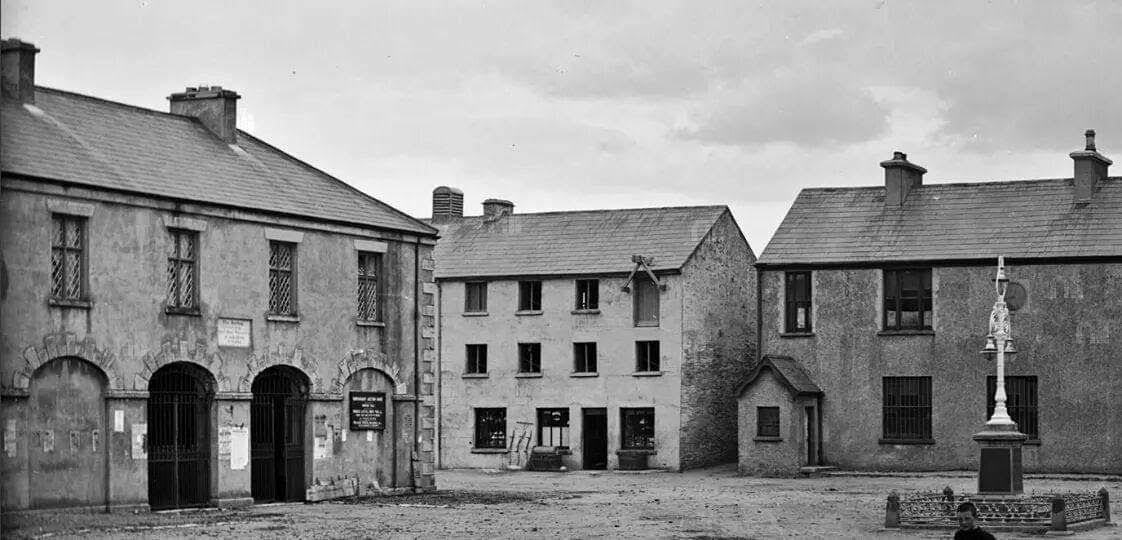By Moses Alcorn
Dunfanaghy’s Market Square has long been the heart of the town, with its history dating back to the late 1830s when the land was reclaimed from the sea. Before this, Dunfanaghy Bay extended as far as where Centra stands today. This land reclamation not only reshaped the town’s geography but also enabled the construction of key buildings, including Ramsay’s Stores, the Ards Estate Office (now the Social Welfare Office), and the Stewart Arms Hotel (now Carrig Rua), all of which have played important roles in the community’s life.
Dunfanaghy has been a market town for centuries, with records indicating that a grant was given to Hugh Hamill to hold markets in Dunfanaghy and Castlederg, Co. Tyrone, on March 6, 1679. By the 1830s, the pier was renovated, followed by the reclamation of the Market Square and surrounding areas. Some of the original structures from this time still stand today, such as the building that now houses Muck’n’Muffins, once a grain store, as well as the Jaws Watersports shop and the sweet shop. The refurbished Dunfanaghy Pier facilitated the arrival of large cargo boats, which allowed the town to import goods and export local produce.
Among the Square’s most iconic landmarks are the Market House and “The Monument,” both of which have become central to the town’s character.
The Market House: Built During the Famine, A Testament to Resilience
The Great Famine brought widespread hardship, and the local Poor Law Commissioners implemented Famine Relief Schemes to assist the destitute, aiming to keep people out of the workhouse. While many of these projects amounted to “roads to nowhere,” two notable exceptions remain in use today: Dunfanaghy’s Market House and Portnablagh Pier.
The Market House was built as part of the Famine Relief Programme, with land donated by A.J.R. Stewart of Ards, the town’s owner at the time. Dunfanaghy, a thriving port, saw regular shipments of coal, grain, and other products, while monthly fairs in the square drew farmers from the surrounding areas to sell their produce. Historical photographs capture the bustling activity, with carts filling the square in front of the Market House.
Today, the Market House is home to Revive and a yoga studio, offering a calm space for locals and visitors. However, in its heyday, the building was a focal point of the town’s most significant events. It functioned as a courthouse and was the epicenter of the monthly fairs when farmers gathered to sell livestock and produce. Deals were sealed with handshakes in a time when cash was king—a far cry from today’s cashless society. After the business was done, many would retire to the local pubs, where it wasn’t uncommon for disputes to erupt, often leading to some participants finding themselves back at the Market House for a court appearance.
One of the building’s most notable roles was as a courthouse. Old pictures show gates at the ground level, designed to allow judges and prisoners to enter and exit discreetly. The Market House gained international attention during the Land War when Canon McFadden was arrested following the death of Inspector Martin. McFadden’s trial, later moved to Portlaoise, drew significant attention, and although he was eventually released, the event cemented the Market House’s place in history.
A few years later, Padraig Pearse, one of the signatories of the 1916 Proclamation, defended Niall Mac Giolla Bhridge in Dublin after the local court initially prosecuted him for having an Irish-language sign on his cart. This case originated at the Dunfanaghy courthouse and is commemorated by a plaque erected in 2016.
While these high-profile cases are part of the Market House’s legacy, the day-to-day proceedings were often more mundane. Records reveal that common offenses included poitín (illicit alcohol) making, working on Sundays (breaking the Sabbath), assault, and farmers being fined for livestock wandering on public roads. These cases reflect the challenges and realities of life in the area at the time, including one unfortunate case of a mother charged with deserting her children, highlighting the dire poverty of the period.
A Hub of Community Life
After Ireland’s independence, the Market House continued to function as a courthouse until the early 1990s. Over the years, it became a vital community hub. For a time, it housed “The Singing Kettle Café,” owned by the late Molly Crossan, and was the venue for dances featuring popular showbands. Boxing fans may recall that Dunfanaghy Boxing Club, founded over 40 years ago, called the Market House home. Coaches like Eddie Harkin and the late Michael Durning trained multiple Irish and Ulster champions here. Renowned boxing personalities, including Derry’s Charlie Nash and American boxer and actor Randall “Tex” Cobb, visited the club during its time at the Market House, delighting fans by mingling with them, unlike the infamous Jack Doyle, who was too preoccupied with the local hospitality to perform.
The Market House also served as a cinema, hosted weekly bingo sessions, and even welcomed Santa Claus during his yearly visits to Dunfanaghy. It was also the site of community celebrations, including the 1978 election of Sammy McGarvey as the Lord Mayor of Dunfanaghy and the town’s 1992 celebration of Donegal’s Sam Maguire Cup victory.
Preserving a Legacy
In recent years, plans have been made to refurbish the Market House, which remains a focal point in Dunfanaghy. For over 170 years, this building has played a central role in the town’s life, bearing witness to historical events and serving as a cherished community space. The ongoing efforts to preserve it underscore its significance, not just to Dunfanaghy but to the wider northwest region.

